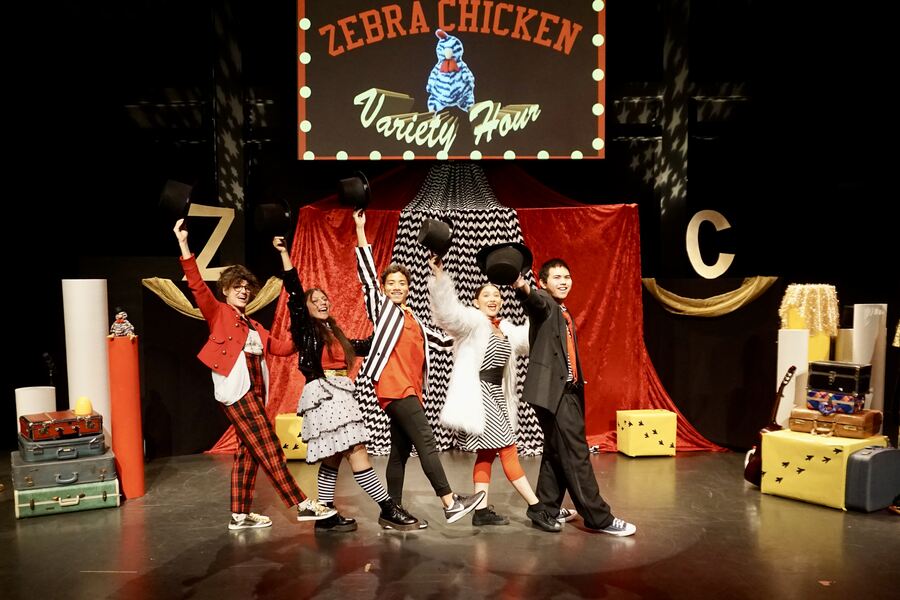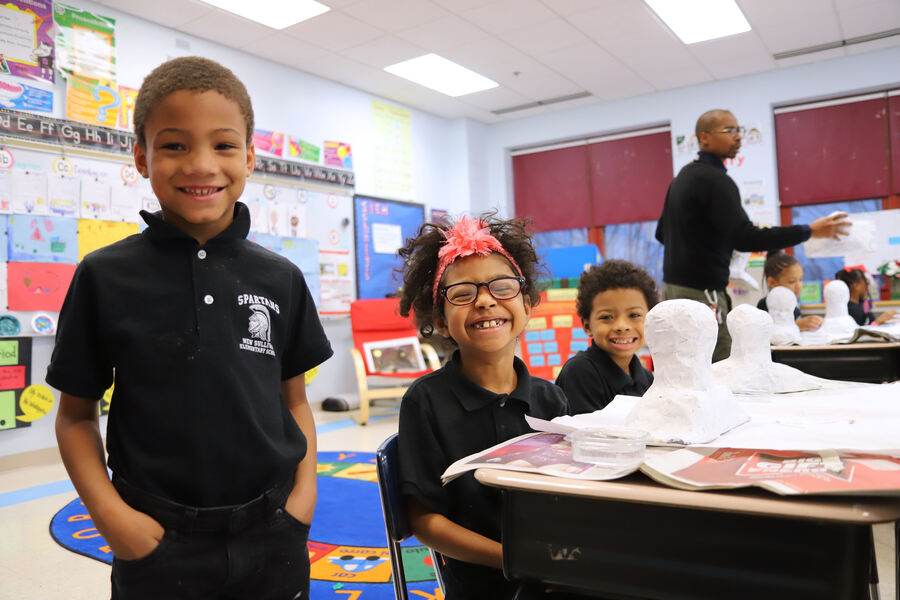What can we say—it’s been a tough few years. As we continue to sand out the rough patches, smoothing the way as best we can for the next generation of artists and art lovers, the researchers behind Wallace Foundation’s new report, The Connected Arts Learning Framework, An Expanded View of the Purposes and Possibilities for Arts Learning, are training their focus on something as intimate as it is universal: friendship.
“We are finding that friends and friendship networks are important for youth to support connections across arts learning,” said the report’s co-author Dr. Maggie Dahn, associate project scientist at the University of California, Irvine, speaking on behalf of the team. “In fact, we have evidence to believe friends and friendships can support the deepening of long-term impacts of the arts, including how connected people feel to arts organizations and arts practice years after formal engagement.”
The fallout from COVID-19 took a heavy toll on young people’s mental health, but with federal relief funds drying up, the role of the arts as a space for healing and connection, particularly for young people, is both more urgent and more precarious than ever. The Connected Arts Learning Framework offers a new lens through which to view the role of arts education, as well as real-world examples of the framework in action.
The report focuses not only on the value of arts education to individual young people, but also to the community as a whole. The framework expands the purposes of arts learning, widening the scope of its benefits beyond academic improvements to include community thriving and a stronger fundamental sense of self-identity and self-worth, in addition to more measurable outcomes such as expanded career opportunities and more active civic engagement. In focusing on communal cultural wealth, the connected arts learning framework explores ways in which leadership opportunities, youth interest-driven programming, and relationships among community networks can intersect to support deep learning and community well-being.
“We’ve heard from arts organizations and leaders in our network that this work resonates with them––that the framework offers language for what some organizations and leaders have been doing all along, and surfaces these practices as outcomes while offering a research-basis for this work,” the authors report. “We have to remember that within OST (out-of-school-time) arts, there isn’t a standard operating procedure for how to do things. What the connected arts learning framework does for the field is that it supports a shared direction.”
Though the path each organization takes varies (the report discusses five), that shared direction invariably points to affirmed identities and stronger community ties stemming from arts institutions. The report’s five case studies illustrate how different organizations approach the connected arts learning framework:
- Culturally Sustaining Arts at Ifetayo Cultural Arts Academy in Brooklyn
- Future Forward Arts at Inner-City Arts in Los Angeles
- Networked Arts at Chicago Arts Partners in Education
- Youth Voice Arts at Spy Hop in Salt Lake City
- Doing Well By Doing Art at OrigiNation in Boston
Ifetayo Cultural Arts Academy’s Culturally Sustaining Arts approach to connected arts learning centers a specific culture in the local community with programming focusing on both its art and history. To connect today’s young artists with the cultures of the African diaspora, Ifetayo not only offers classes in traditional African arts, but also looks at more modern concerns through a culturally specific historical lens. When teaching budgeting, for example, students are given the greater context of what their ancestors did in times of plenty and scarcity. This approach centers existing cultural assets while connecting deeply with heritage and history. It also affirms and supports cultural identities through intergenerational relationships and fosters community pride through shared cultures.
In the Future Forward approach, meanwhile, organizations tie arts education to workplace readiness and civic engagement by fostering mentorships between young people, activists, and working artists. Inner-City Arts’ Work of Art program puts young people interested in a career in the arts into contact with mentors in the L.A. arts industry for leadership and work opportunities. The mentors and mentees meet at least twice a year to discuss young artists’ areas of interest, then curate workplace shadowing experiences based on those discussions. The program also offers college application counseling and résumé and network-building coaching. In preparing young people for careers in the arts, the Future Forward approach not only bolsters and supports the individual student, but also contributes to a more equitable and diverse arts industry, giving historically marginalized students the tools, experiences, and connections they need to navigate and ultimately thrive in the field.

In the Networked Arts approach, different social networks connect with each other to explore and support the systems in a participant’s life outside of arts education. Organizations use online platforms, shared learning spaces, and local institutions to actively engage not only the youth themselves, but also their families, mentors, teachers, and wider community. The Wallace report discusses Chicago Arts Partners in Education (CAPE), where teachers and teaching artists model this framework by closely partnering to co-create an art-integrated curriculum over the course of at least one year. They share reflections from the process with their students, modeling new forms of collaboration, risk-taking, and vulnerability. In these Networked Arts connections, all participants deepen their understanding and appreciation of the interrelationships of previously disparate spaces.
And, frankly, forming bonds among organizations has pragmatic benefits as well. Organizations need friends as much as the young people they serve do. “In practice, part of the vision that connected arts learning supports is not just writing individual grant proposals as an organization but teaming up with others in your network to write proposals and create supportive infrastructures together,” the researchers say. “We sense a move of cities and states in taking on more for arts organizations and acting as intermediaries to help take care of fundraising efforts. We imagine that finding like-minded partners to engage together as part of a network can support generative work aligned with a connected arts learning framework.”
Speaking of boots-on-the-ground local government action, the connected arts learning framework looks at that too. The Youth Voice Arts approach supports civic engagement by elevating youth voices and their participation. Young people engage with civic activism through artmaking and arts education on a number of different platforms, from social media to live performance. They are invited into advisory roles and encouraged to bring their own lived experiences to the table as they voice their concerns and follow their interests. As in many of these approaches, youth interest is an integral part of programming. The Youth Voice Arts approach is well exemplified best by Spy Hop, which recently created a podcasting program based on feedback gathered through formal and informal channels. The program provides its participants with a platform run by them and for them to candidly share their thoughts with their listeners. This connected arts learning approach allows youth interest to guide programming, giving them a greater sense of agency and responsibility to their community, while giving the community at large direct messages about the concerns of tomorrow.
Finally, Doing Well by Doing Art uses the connected arts learning framework to focus on the emotional and social well-being component of arts education. By using the arts to process negative emotions and trauma, this lens of the framework aims to build self-esteem and celebrate artistic expression. For the youth in OrigiNation, which serves primarily Black and Latinx students in the greater Boston area, this takes the shape of artmaking, which can help address societal harm and illustrate a path to healing—as with a recent dance performance which reckoned with prejudice and gave space for an alternative narrative. This approach moves beyond the stage, aiming to deepen familial ties through connection with culture and history and broadening the understanding of family itself. OrigiNation’s goals of joy, self-esteem, and physical and mental health reflect the hallmarks of Doing Well by Doing Art: holistic healing, identity development, and collaboration.
The path of the arts has always been daunting, which is why a nuanced understanding of the multifaceted inroads and outcomes of arts education is integral to supporting a rich and equitable cultural ecology for everyone. The Connected Arts Learning Framework report concludes with rubric and reflection questions for each organization to work through, as well as guidance for community mapping and possible areas for future research.
When asked about some of the potential roadblocks to this work, the team acknowledged that the outcomes Connected Arts Learning suggests “may be a challenge for some funders/organizations and their bottom lines. More work needs to be done in terms of turning this framework into leveraging high-quality practices that make connected arts learning happen for young people.” But in a time of increased specialization and often alarming polarization, connections among arts organizations should not be undervalued. “By networking arts organizations with other arts organizations and groups (including community groups, businesses, and schools), there is a chance to lighten the load and bring more voices to the table that create partnerships that support better, more connected arts learning.”
Rachael Hip-Flores (she/her) has assisted TCG in architecting and organizing the information gleaned from the Audience Revolution program to be easily accessed and shared, compiled funding resources during the worst of the pandemic, helped build and maintain the Circle website, managed TCG’s Twitter and Facebook accounts, liaised with theatre journalists and experts in various fields regarding everything from activism to book releases, and supported the creation and dissemination of TCG’s external-facing communications. Outside of TCG work, Rachael is an actress on stage, screen, and in voiceover, as well as a freelance fact-checker and qualitative researcher at Blue Lime US. She has a BFA in Theatre from Mason Gross School of the Arts at Rutgers University.


